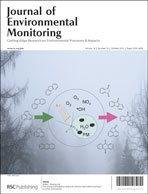Trace element mobility and transfer to vegetation within the Ethiopian Rift Valley lake areas†
Abstract
To evaluate critical trace element loads in native vegetation and calculate soil-to-plant transfer factors (TFs), 11 trace elements (Cr, Co, Ni, Cu, Zn, As, Se, Mo, Cd, Pb and Mn) have been determined in leaves of 9 taxonomically verified naturally growing terrestrial plant species as well as in soil samples collected around 3 Ethiopian Rift Valley lakes (Koka, Ziway and Awassa). The Cr concentration in leaves of all the plant species was higher than the “normal” range, with the highest level (8.4 mg per kg dw) being observed in Acacia tortilis from the Lake Koka area. Caper species (Capparis fascicularis) and Ethiopian dogstooth grass (Cynodon aethiopicus) from Koka also contained exceptionally high levels of Cd (1 mg per kg dw) and Mo (32.8 mg per kg dw), respectively. Pb, As and Cu concentrations were low in the plant leaves from all sites. The low Cu level in important fodder plant species (Cynodon aethiopicus, Acacia tortilis and Opuntia ficus-indicus) implies potential deficiency in grazing and browsing animals. Compared to the Canadian environmental quality guideline and maximum allowable concentration in agricultural soils, the total soil trace element concentrations at the studied sites are safe for agricultural crop production. Enrichment factor was high for Zn in soils around Lakes Ziway and Awassa, resulting in moderate to high transfer of Zn to the studied plants. A six step sequential extraction procedure on the soils revealed a relatively high mobility of Cd, Se and Mn. Strong association of most trace elements with the redox sensitive fraction and mineral lattice was also confirmed by partial redundancy analysis. TF (mg per kg dw plants/mg per kg dw soil) values based on the total (TFtotal) and mobile fractions (TFmobile) of soil trace element concentrations varied widely among elements and plant species, with the averaged TFtotal and TFmobile values ranging from 0.01–2 and 1–60, respectively. Considering the mobile fraction in soils should be available to plants, TFmobile values could reflect trace elements transfer to plants in the most realistic way. However, the present study indicates that TFtotal values also reflect the transfer of elements such as Mn, Cd and Se to plants more realistically than TFmobile values did.


 Please wait while we load your content...
Please wait while we load your content...